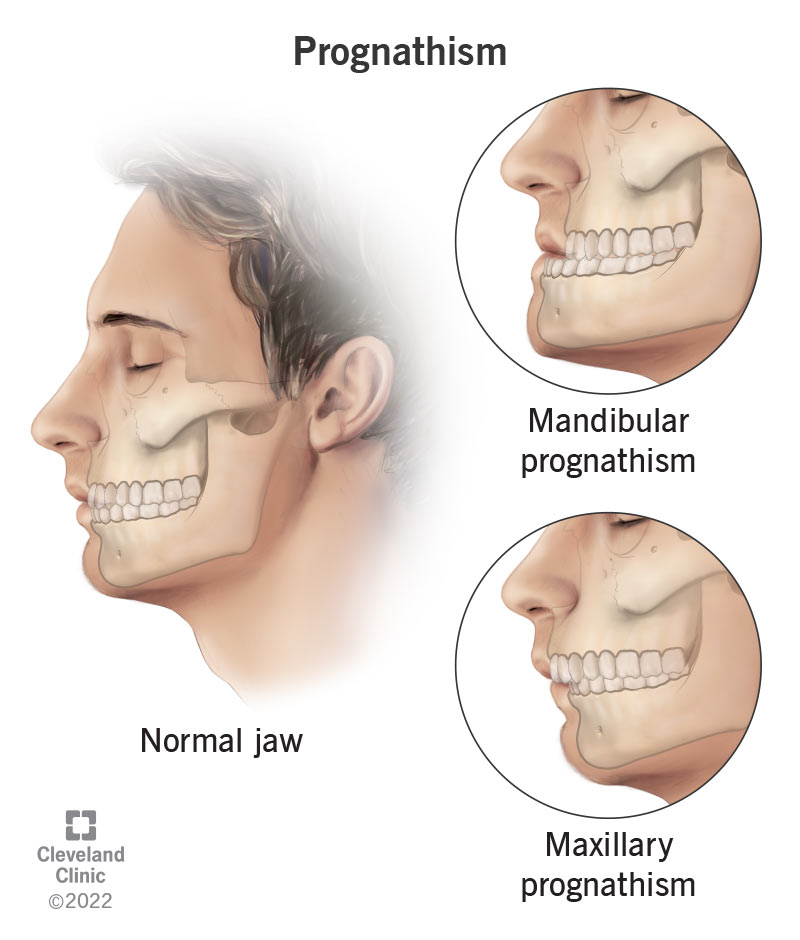Prognathism is a protrusion of your upper jaw, lower jaw or both. This condition may be inherited, or an underlying health condition could cause it. Treatment involves a combination of corrective jaw surgery and orthodontics.
Advertisement
Cleveland Clinic is a non-profit academic medical center. Advertising on our site helps support our mission. We do not endorse non-Cleveland Clinic products or services. Policy

Prognathism is when your upper jaw, lower jaw or both jaws protrude (jut out). It can look different ways, depending on the type:
Advertisement
Cleveland Clinic is a non-profit academic medical center. Advertising on our site helps support our mission. We do not endorse non-Cleveland Clinic products or services. Policy
Sometimes, prognathism is barely noticeable and doesn’t cause health issues. If this is your situation, you likely won’t need treatment.
If it’s more severe, though, it can cause a misaligned bite (malocclusion). Malocclusion can cause a number of health issues. It can lead to dental wear and tear, chewing difficulties and speech problems. A healthcare provider can recommend treatments that can help.
A prognathic jaw may or may not cause symptoms, depending on its severity. In addition to having a protruding jaw, symptoms may include:
Prognathism is a congenital condition. This means you’re born with it. Often, parents pass down genes to their biological children that cause one jaw to be larger than another. Sometimes, it’s a sign of a condition or syndrome, like:
Advertisement
While prognathism usually presents at birth, it can happen later in life due to dental injuries (like blunt force trauma to your mouth). Rarely, it can happen because of childhood habits, like thumb sucking or pacifier use. In excess, these habits can impact how the bones in your child’s face develop.
Prognathism can lead to:
Your healthcare provider will examine you and ask questions about your symptoms and family history. They may also take:
Treatment depends on the severity of your condition. Usually, skeletal issues like prognathism require surgery. Orthodontic treatments, like braces, may be all you need when prognathism is mild. But usually, treatment involves both.
Also called orthognathic surgery, corrective jaw surgery repositions your jaw bones to improve health, function and appearance. Once these bones are positioned properly, your teeth will fit together better, as well.
If you’re like most people, you’ll begin treatment with braces or clear aligners. Once your teeth are in better alignment, you’ll get jaw surgery. But treatment is different for everyone. Your healthcare provider will explain what to expect.
If you have a protruding jaw, talk to your provider. They can help determine if prognathism is a cosmetic issue or if it’s interfering with your health and function. If your condition causes serious issues — like trouble chewing or breathing — call your provider right away.
Advertisement
If you have a prognathic jaw, your healthcare provider will discuss your treatment options with you in detail. Chances are, you’ll need surgery to correct the issue.
If you’re planning on having children and want to know if there’s a chance of passing a condition to them, see a genetics counselor. They can help you understand how likely it is that your child will inherit a prognathic jaw.
In very mild cases, orthodontics alone may be enough to correct this condition, but this isn’t the norm. Braces can move teeth, but they can’t move your facial bones. So, if skeletal abnormalities are moderate or severe, then you’ll likely need surgery.
Prognathism can have a significant impact on your dental health. But jaw surgery can fix the prognathism and reduce dental wear and tear. It can improve your chewing function and help with other related symptoms. If you think you might have prognathism, talk to your healthcare provider. They can find a solution to meet your needs.
Advertisement
If you have conditions affecting your ears, nose and throat, you want experts you can trust. Cleveland Clinic’s otolaryngology specialists can help.

Last reviewed on 10/22/2025.
Learn more about the Health Library and our editorial process.